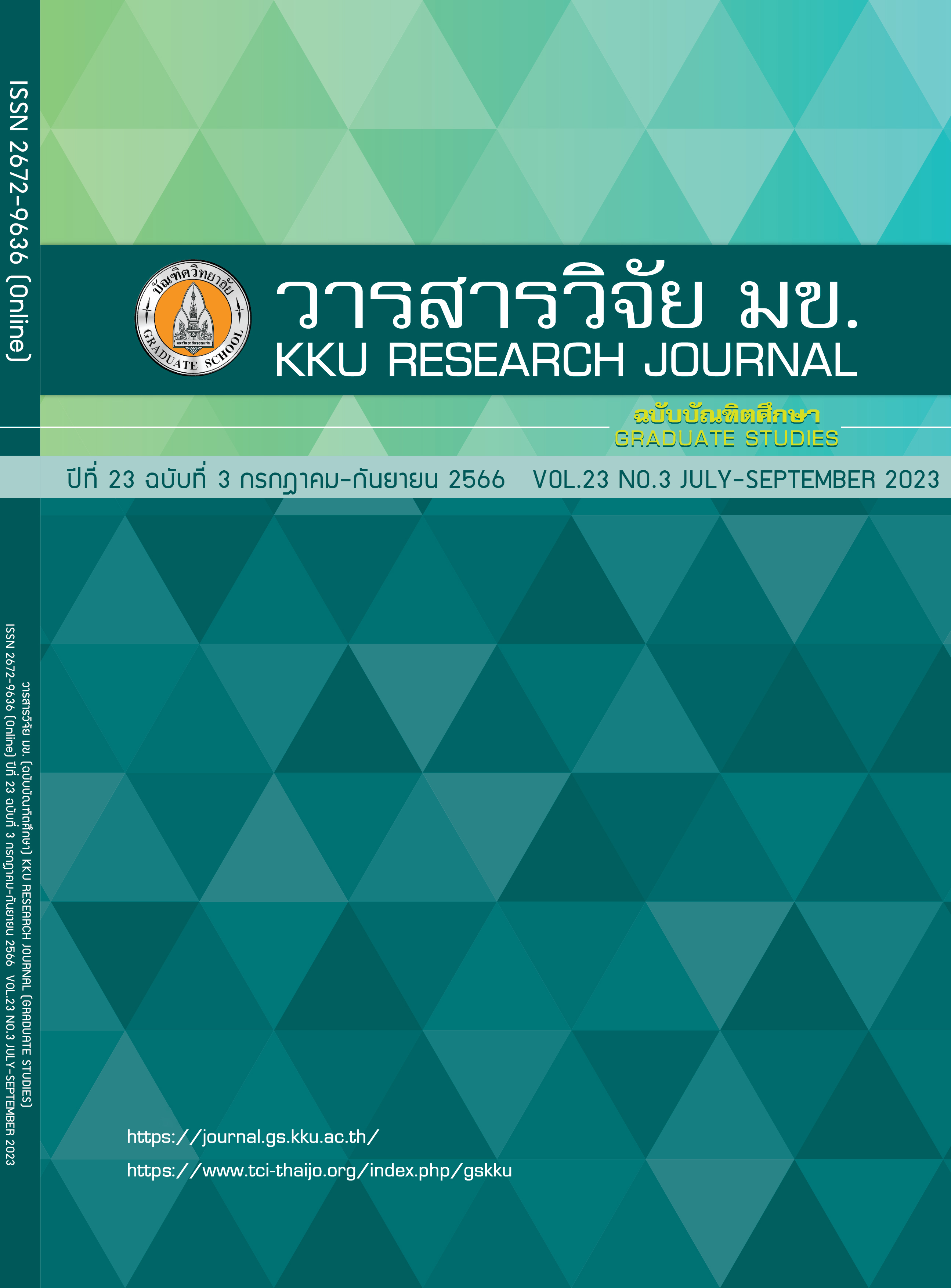Decolorization of Methylene Blue via Microsecond Pulsed Plasma in Atmospheric Gases
Keywords:
Non-thermal plasma, Pulsed corona discharge, Methylene blueAbstract
A novel vertical bubble reactor with microsecond plasma discharge was designed for methylene blue decolorization. The effect of changing the type of feed gas in the plasma reactor (air, oxygen, argon, and nitrogen) on the decolorization efficiency was investigated. All the feed gases achieved methylene blue decolorization higher than 95% within 30 min, while the energy required for 50% decolorization (Y50) was 1.415, 0.954, 0.786, and 0.586 g/kWh for oxygen, air, argon, and nitrogen, respectively. By fitting with ln(Ct/C0), the reaction time varied linearly with the reaction time, indicating that the decolorization reaction exhibited pseudo-first-order behavior. Finally, coumarin was used as an OH radical scavenger, demonstrating that OH radicals were the main active species in the decolorization reaction. These OH radicals may have been generated from ozone and hydrogen peroxide. Considering the economics and the decolorization efficiency, these results suggest that air is a promising feed gas candidate for methylene blue decolorization.
References
Krosuri A, Wu S, Bashir MA, Walquist M. Efficient degradation and mineralization of methylene blue via continuous-flow electrohydraulic plasma discharge. Journal of Water Process Engineering. 2021; 40(January):101926.
Varjani S, Rakholiya P, Shindhal T, Shah A V, Ngo HH. Trends in dye industry effluent treatment and recovery of value added products. Journal of Water Process Engineering. 2021;39 (June):101734.
Jegatheesan V, Pramanik BK, Chen J, Navaratna D, Chang CY, Shu L. Treatment of textile wastewater with membrane bioreactor: A critical review. Bioresource Technology. 2016; 204:202–212.
Ministry of Industry. Announcement of the Ministry of Industry entitled the Treated Effluent Standards from Factories. Royal Government Gazette. 2017;134(153d):11–15.
Tange K, Nomura S, Nakajima J. Methylene blue decomposition via various in-liquid plasma methods. Nihon Enerugi Gakkaishi/Journal of the Japan Institute of Energy. 2020;99(8):99–103.
Rekhate C V, Srivastava JK. Recent advances in ozone-based advanced oxidation processes for treatment of wastewater- A review. Chemical Engineering Journal Advances. 2020;3(June):100031.
Magureanu M, Bradu C, Piroi D, Mandache NB, Parvulescu V.Pulsed corona discharge for degradation of methylene blue in water. Plasma Chemistry and Plasma Processing. 2013;33(1):51–64.
García MC, Mora M, Esquivel D, Foster JE, Rodero A, Jiménez-Sanchidrián C, et al. Microwave atmospheric pressure plasma jets for wastewater treatment: Degradation of methylene blue as a model dye. Chemosphere. 2017; 180:239–246.
Wang B, Dong B, Xu M, Chi C, Wang C. Degradation of methylene blue using double-chamber dielectric barrier discharge reactor under different carrier gases. Chemical Engineering Science. 2017;168:90–100.
Zeghioud H, Nguyen-Tri P, Khezami L, Amrane A, Assadi AA. Review on discharge Plasma for water treatment: mechanism, reactor geometries, active species and combined processes. Journal of Water Process Engineering. 2020;38(May):101664.
Khan I, Saeed K, Zekker I, Zhang B, Hendi AH, Ahmad A, et al. Review on Methylene Blue: Its Properties, Uses, Toxicity and Photodegradation. Vol. 14, Water (Switzerland). MDPI; 2022.
Wang S, Zhu ZH, Coomes A, Haghseresht F, Lu GQ. The physical and surface chemical characteristics of activated carbons and the adsorption of methylene blue from wastewater. Journal of Colloid and Interface Science. 2005;284(2):440–446.
Bulusu RKM, Wandell RJ, Gallan RO, Locke BR. Nitric oxide scavenging of hydroxyl radicals in a nanosecond pulsed plasma discharge gas-liquid reactor. Journal of Physics D: Applied Physics. 2019;52(50).
Liang JP, Zhao ZL, Zhou XF, Yang DZ, Yuan H, Wang WC, et al. Comparison of gas phase discharge and gas-liquid discharge for water activation and methylene blue degradation. Vacuum. 2020;181(July):109644.
Dubois D, Merbahi N, Eichwald O, Yousfi M, Benhenni M. Electrical analysis of positive corona discharge in air and N2, O2, and C O2 mixtures. Journal of Applied Physics. 2007;101(5).
Wandell RJ, Bresch S, Wang H, Babicky V, Lukes P, Locke BR. The effects of pulse frequency on chemical species formation in a nanosecond pulsed plasma gas-liquid film reactor. International Journal of Plasma Environmental Science and Technology. 2020;14(1):1–9.
Wu L, Xie Q, Lv Y, Wu Z, Liang X, Lu M, et al. Degradation of methylene blue via dielectric barrier discharge plasma treatment. Water (Switzerland). 2019;11(9).
Chandana L, Manoj Kumar Reddy P, Subrahmanyam C. Atmospheric pressure non-thermal plasma jet for the degradation of methylene blue in aqueous medium. Chemical Engineering Journal. 2015 Dec 15; 282:116–122.
Chasanah U, Yulianto E, Zain AZ, Sasmita E, Restiwijaya M, Kinandana AW, et al. Evaluation of Titration Method on Determination of Ozone Concentration produced by Dielectric Barrier Discharge Plasma (DBDP) Technology. In: Journal of Physics: Conference Series. Institute of Physics Publishing; 2019.
Bolouki N, Kuan WH, Huang YY, Hsieh JH. Characterizations of a plasma-water system generated by repetitive microsecond pulsed discharge with air, nitrogen, oxygen, and argon gases species. Applied Sciences (Switzerland). 2021 Jul 1;11(13).
Brun E, Girard HA, Arnault JC, Mermoux M, Sicard-Roselli C. Hydrogen plasma treated nanodiamonds lead to an overproduction of hydroxyl radicals and solvated electrons in solution under ionizing radiation. Carbon N Y. 2020; 162:510–518.
De-Nasri SJ, Nagarajan S, Robertson PKJ, Ranade V. Quantification of hydroxyl radicals in photocatalysis and acoustic cavitation: Utility of coumarin as a chemical probe. Chemical Engineering Journal. 2021;420.
Standard Methods for the Examination of Water and Wastewater. APHA, AWWA, WEF, 23rd edition, 2017.
Motoki Y, Wahayudiono, Siti M, Hedeki K, Motonobu G. Nonthermal Atmospheric Pressure Plasma for Methylene Blue Dye Decolorization by Using Slug Flow Reactor System. Plasma Chemistry and Plasma Processing. 2020;40(Published: 04 February 2020):985–1000.
Nishiyama H, Nagai R, Ninuma K, Tanaka H. Characterization of DBD multiple Jets for Methylene Blue Decoloerization. Journal of fluid Science and technology. 2013;8.
Nashmi OA, Abdulrazzaq NN, Mohammed AA. Removal of methylene blue from aqueous solution by ozone microbubbles. Association of Arab Universities Journal of Engineering Sciences. 2020 Sep 30;27(3):31–40.
Malik MA. Water purification by plasmas: Which reactors are most energy efficient? Plasma Chemistry and Plasma Processing. 2010 Feb;30(1):21–31.
Downloads
Published
Issue
Section
License
Copyright (c) 2023 KKU Research Journal (Graduate Studies)

This work is licensed under a Creative Commons Attribution-NonCommercial-NoDerivatives 4.0 International License.



